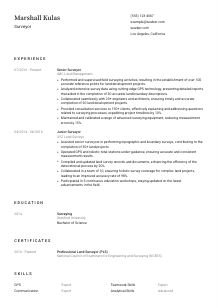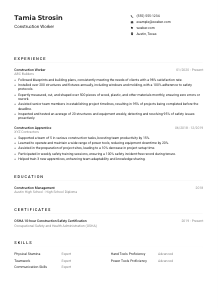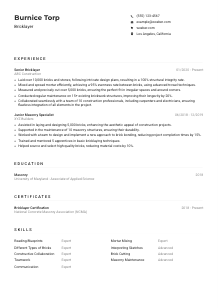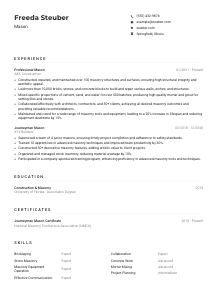Surveyor Resume Example
Mapping terrains, but your resume is off the grid? Get oriented with this Surveyor resume example, aligned with Wozber free resume builder. Learn how to plot your surveying expertise to meet job coordinates, guiding your career toward clearer horizons!
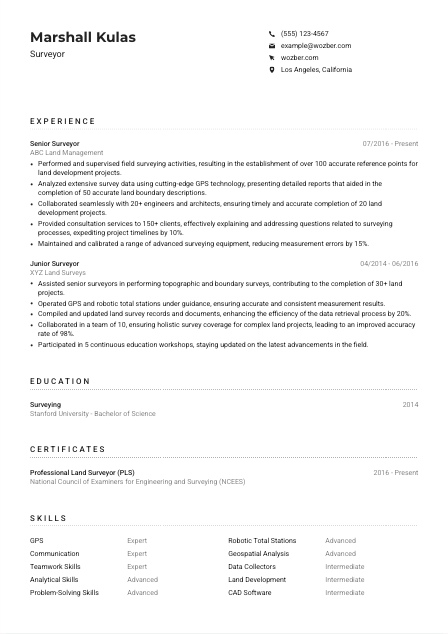
How to write a Surveyor Resume?
Greetings, budding Surveyor champion! Standing out in the fiercely competitive job landscape requires more than mere ambition; it demands a strategic artifact - your resume. Not just any resume, but one sculpted with precision, reflecting your unmatched surveying acumen. Leveraging Wozber, a free resume builder designed with cutting-edge resume-writing practices, this guide will navigate you through tailoring your resume with an ATS-friendly resume format, ensuring it resonates with your dream Surveyor role. Let's plot the course to your job-winning resume!
Personal Details
Crafting an inviting Personal Details section is akin to laying the foundational cornerstones for a survey. Precision here sets the stage. Follow these steps, closely aligning your introduction with the Surveyor position requirements, ensuring you open with a professional and job-specific touch.
1. Brand Yourself Boldly
Consider your name the headline of your professional narrative. Opt for a clear, professional font, perhaps a shade bolder or slightly larger than the body text, ensuring you're memorable from the get-go.
2. Mirror the Desired Role
"Surveyor" isn't just a job title; it's an identity. Include this designation prominently on your resume, directly under your name, establishing immediate relevance to the job you're pursuing.
3. Essential Contact Information
Double-check your phone number for accuracy - a missed digit can mean a missed opportunity. Stick to a professional email format (firstname.lastname@example.com), steering clear of whimsical or outdated handles.
4. Geo-tag Yourself
Geolocation matters in surveying and job hunting alike. Stating "Los Angeles, California" not only meets the job's location requirement but also signals to employers that you're ready and able to hit the ground running with no relocation delays.
5. Web Presence
If you have a LinkedIn profile or a professional portfolio site showcasing your projects, include this link. Ensure it acts as a mirror to your resume, reinforcing your skills and experiences.
Takeaway
Think of the Personal Details section as preparing a site for a survey. It's the initial mark, crucial for the journey ahead. Precision and alignment with the Surveyor role are key. This section doesn't just share your contact info; it marks the coordinates for your career's next big step. Set it with care.





Experience
The Experience section is your terrain to showcase the scopes you've navigated, the lands you've measured, and the projects you've brought to life. Here's how to plot your professional landmarks, ensuring they align faultlessly with your next Surveyor position.
- Performed and supervised field surveying activities, resulting in the establishment of over 100 accurate reference points for land development projects.
- Analyzed extensive survey data using cutting‑edge GPS technology, presenting detailed reports that aided in the completion of 50 accurate land boundary descriptions.
- Collaborated seamlessly with 20+ engineers and architects, ensuring timely and accurate completion of 20 land development projects.
- Provided consultation services to 150+ clients, effectively explaining and addressing questions related to surveying processes, expediting project timelines by 10%.
- Maintained and calibrated a range of advanced surveying equipment, reducing measurement errors by 15%.
- Assisted senior surveyors in performing topographic and boundary surveys, contributing to the completion of 30+ land projects.
- Operated GPS and robotic total stations under guidance, ensuring accurate and consistent measurement results.
- Compiled and updated land survey records and documents, enhancing the efficiency of the data retrieval process by 20%.
- Collaborated in a team of 10, ensuring holistic survey coverage for complex land projects, leading to an improved accuracy rate of 98%.
- Participated in 5 continuous education workshops, staying updated on the latest advancements in the field.
1. Chart the Terrain
Begin by dissecting the job description. Look for specific experiences that resonate. Highlighted needed skills such as 'land surveying, including boundary, topographic, and construction surveys' should serve as markers for tailoring your own experience reflections.
2. Map Out Your Journey
Structure your roles chronologically, ascending from most recent. Each should detail not just your title and tenure but the company's name and your time there. This structure offers clear navigational beacons through your career landscape.
3. Stake Your Claims
For each role, carve out accomplishments that speak directly to the job requirements. Avoid generic descriptions. Instead, detail how you've mapped over "100 accurate reference points" or "reduced measurement errors by 15%" using advanced equipment.
4. Quantify Your Survey
Numbers are your coordinates here, offering tangible proof of your contributions. Whether it's the number of projects led, the percentage improvement of processes, or the scale of surveys conducted, quantify your impact clearly.
5. Relevant Landscapes Only
Just as a surveyor wouldn't map unnecessary terrain, exclude experiences unrelated to surveying. Keep the focus sharp on roles and accomplishments that signal your prowess in the fields explicitly mentioned in the job description.
Takeaway
Your experience section narrates your professional journey's contours and depths. By strategically showcasing relevant, quantified accomplishments, you signal to hiring managers not just your readiness but your passion for the craft of surveying. It's about proving you're not only a fit for the role but that your resume reads like a plotted map leading directly to you.
Education
In the world of surveying, your educational background sets the stage for your professional expertise. Craft your Education section to reflect not just your qualifications but your alignment with the Surveyor role's prerequisites.
1. Identify Core Requirements
Pinpointing the educational needs is your first task. For Surveyor roles, this often means a "Bachelor's degree in Surveying, Geomatics, or a related field." List your relevant degree upfront, ensuring it's a direct match.
2. Keep the Layout Clear
Structure this section for easy navigation: degree title, field of study, institution name, and graduation date. This clarity helps hiring managers quickly confirm your educational qualifications.
3. Exact Degree Match
When your degree directly aligns with the job requirement, as a "Bachelor of Science in Surveying" does for this Surveyor role, it's a key point of emphasis. It's a direct confirmation of your foundational knowledge in the field.
4. Relevant Coursework and Achievements
If you're early in your career, detailing relevant coursework or surveying projects can bolster your profile. Include this information to show the breadth of your knowledge and your proactive approach to learning.
5. Additional Educational Highlights
Participation in relevant clubs, activities, or organizations related to surveying can add depth to your educational background. These details can show a commitment to your field beyond the classroom.
Takeaway
Your education section is a plotted course of your academic journey, emphasizing your readiness for the Surveyor role. By aligning it with the job's requirements, you underline not just your qualifications but your dedication to the profession. It's a foundational piece of your professional map, guiding you towards your career destinations.
Certificates
In the evolving landscape of surveying, certifications can be powerful markers of your expertise and commitment to professional growth. Here's how to effectively incorporate them in your resume, spotlighting your specialized skills.
1. Survey the Job Terrain
First, assess if the job hints at preferred certifications. Though not explicitly mentioned, a certificate like "Professional Land Surveyor (PLS)" underscores your validated skills and dedication, making it a beacon of your expertise.
2. Select Relevant Landmarks
Aim for certifications closely matching the job requirements or enhancing your surveying profile. Display the most relevant certifications, ensuring they resonate with the role's demands and elevate your candidacy.
3. Mark Your Calendar
For certificates with validity periods, include the dates of acquisition or expiry. This detail provides context and shows your credentials are current, underscoring your ongoing commitment to professional development.
4. Continuous Learning
Surveying is an ever-adapting field. Staying updated with the latest certifications not only boosts your resume but also demonstrates a proactive approach to your professional evolution. Regular updates signal you're at the forefront of industry standards.
Takeaway
Certificates are your resume's benchmarks, showcasing your mastery and dedication to the surveying profession. By strategically selecting and presenting your certifications, you illuminate your path to stand out as a top-tier candidate, ready to navigate the complexities of the field.
Skills
The Skills section of your resume is the toolbox at your disposal, boldly displaying your capabilities. For a Surveyor, this means showcasing a blend of technical proficiency and soft skills that match the demands of the job.
1. Decode the Terrain
Start by unpacking the job listing, identifying the necessary skill sets. Skills like "proficiency with surveying equipment" and "strong analytical and problem-solving skills" are essentials waiting to be highlighted on your resume.
2. Select Your Tools
Choose skills from your repertoire that align with the job requirements. Ensure a mix of hard skills, such as "GPS and robotic total stations," and soft skills, like "excellent communication and teamwork." This balance showcases your multifaceted capability.
3. Layout with Precision
Organize your skills section clearly, categorizing between technical prowess and interpersonal skills. This methodical approach allows hiring managers to quickly gauge your fit for the role, underscoring your suitability from a holistic perspective.
Takeaway
Your skills are the instruments in your Surveyor's kit. Carefully selected and presented, they compel hiring managers to see you as the perfect candidate, blending technical expertise with the soft skills necessary to navigate the complex terrain of the field.
Languages
In a role that often bridges different territories and cultures, your linguistic arsenal can be a tangible asset. Here's how to showcase your language skills, making them a compelling part of your Surveyor resume.
1. Parse the Requirements
Examine the job description for any specific linguistic needs. For our Surveyor role requiring "Fluent English," this skill takes precedence, positioning you as a clear communicator in the project's primary language.
2. Prioritize and List
List English at the forefront of your languages, marking your fluency. Then, consider including additional languages, especially if they are relevant to the region or clients you'll serve, further showcasing your versatility.
3. Be Honest with Proficiency Levels
Clearly outline your proficiency in each language using terms like "native," "fluent," "intermediate," and "basic." This transparency assures employers of your communication capabilities across different project stages or negotiations.
4. Gauge Role's Scope
For roles with a regional focus or those involving diverse stakeholders, multiple languages can significantly enhance your appeal as a candidate, emphasizing your ability to navigate multicultural environments effectively.
5. Continuous Enhancement
The ability to communicate in multiple languages not only broadens your professional horizons but also enriches your personal growth. View each language as a bridge to new connections, understanding, and opportunities in the surveying field.
Takeaway
Your languages are like surveying tools, each opening new territories of understanding and engagement. Embrace and highlight your linguistic skills, and see them as essential components of your professional surveyor kit, making you a valuable asset in a globally interconnected world.
Summary
A compelling Summary section is the panoramic vista of your resume, offering a broad, captivating view of your surveying landscape. Tailoring it to the Surveyor position means highlighting the most picturesque peaks of your career.
1. Survey the Horizon
First, absorb the essence of the job posting, allowing you to mirror its demands in your summary. This overview sets the direction, ensuring every word maps back to what the job seeks.
2. Plant Your Flag
Open with a powerful introduction, encapsulating your professional identity. "Surveyor with over nine years of demonstrated expertise" not only defines your role but also instantly communicates your depth of experience.
3. Navigate Through Key Skills
Weave into your summary the core skills and achievements that directly address the job's requirements. Showcasing your abilities in "utilizing cutting-edge equipment" or "delivering reliable consultation" tells a story of proven success and technical proficiency.
4. Map It Concisely
While tempting to detail every accomplishment, the power of a summary lies in brevity. Aim for a succinct but impactful narrative, enticing hiring managers to delve deeper into the landscape of your resume.
Takeaway
Your Summary is the overview map of your professional journey, guiding potential employers through the terrain of your career. Tailored and concise, it marks you as the ideal candidate from the outset, inviting deeper exploration into the unique geography of your experiences and skills.
Launching Your Surveyor Journey
Congratulations on navigating the art of crafting a precision-targeted Surveyor resume! With these insights and Wozber's free resume builder at your disposal, including an ATS-friendly resume template and ATS resume scanner, you're well-equipped to create a resume that not only meets but exceeds job specifications. Your resume is the compass guiding your career trajectory. Adjust it, make it unique, and let it lead you to your next professional milestone.
The surveying field awaits your expertise. Embark confidently, and chart your course to success!

- Bachelor's degree in Surveying, Geomatics, or a related field.
- Minimum of 5 years' experience in land surveying, including boundary, topographic, and construction surveys.
- Proficiency with surveying equipment such as GPS, robotic total stations, and data collectors.
- Strong analytical and problem-solving skills with the ability to interpret data and make accurate calculations.
- Excellent communication and teamwork skills to interact with clients, property owners, and colleagues.
- Fluent English is a requirement for this position.
- Must be located in Los Angeles, California.
- Perform field surveying activities, including measurements, staking, and establishing reference points.
- Analyze survey data and prepare detailed reports, including maps, sketches, and legal descriptions.
- Collaborate with other professionals, such as engineers and architects, to ensure accurate land development projects.
- Provide consultation services to clients, addressing any questions or concerns related to land boundaries or surveying processes.
- Maintain and calibrate surveying equipment to ensure accuracy.





